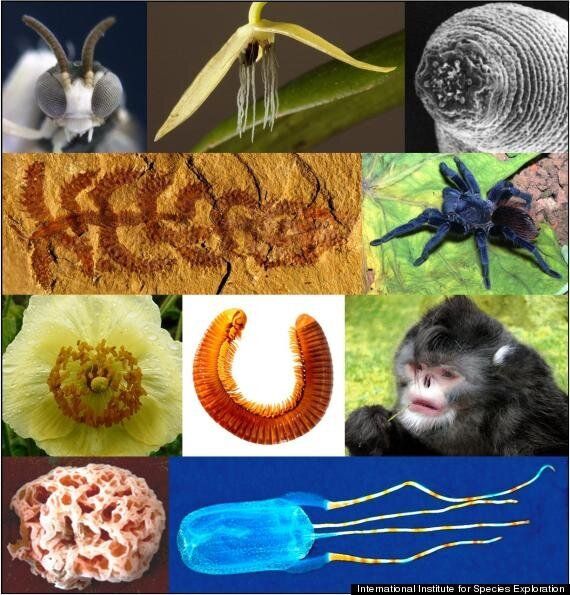There were more than 200 new species discovered last year – but now an international committee of scientists have drawn up their list of the top 10.
Picked for being the most unusual and fascinating, the life forms that made the grade – in no particular order - are: a teensy attack wasp, night-blooming orchid, underworld worm, ancient “walking cactus” creature, blue tarantula, Nepalese poppy, giant millipede, a sneezing monkey, Spongiforma squarepantsii fungus – named after a rather famous cartoon character - and a beautiful but venomous jellyfish.
This year's top 10 come from Brazil, Myanmar, the Dutch Caribbean, South Africa, Papua New Guinea, Spain, Borneo, Nepal, China and Tanzania.

From top left, clockwise: Teensy attack wasp, night-blooming orchid, underworld worm, ancient “walking cactus” creature, blue tarantula, Nepalese poppy, giant millipede, sneezing monkey, Spongiforma squarepantsii fungus and a beautiful but venomous jellyfish
This is the fifth year for the top 10 new species list, released on May 23 to coincide with the anniversary of the birth of Carolus Linnaeus, the Swedish botanist who was responsible for the modern system of plant and animal names and classifications.
It’s decided by The International Institute for Species Exploration at Arizona State University and a committee of scientists from around the world.
"The top 10 is intended to bring attention to the biodiversity crisis and the unsung species explorers and museums who continue a 250-year tradition of discovering and describing the millions of kinds of plants, animals and microbes with whom we share this planet," said Quentin Wheeler, an entomologist who directs the International Institute for Species Exploration at ASU.
Members of the international committee who made their selection from more than 200 nominations look for “species that capture our attention because they are unusual or because they have traits that are bizarre”, according to Mary Liz Jameson, an associate professor at Wichita State University, who chaired the international selection committee.
She added: "Some of the new species have interesting names, some highlight what little we really know about our planet.”
MORE ABOUT THE TOP 10
Sneezing monkey: Rhinopithecus strykeri, named in honour of Jon Stryker, president and founder of the Arcus Foundation, is the first snub-nosed monkey to be reported from Myanmar and is believed to be critically endangered. It is distinctive for its mostly black fur and white beard and for sneezing when it rains. See video below.
Bonaire banded box jelly: This strikingly beautiful yet venomous jellyfish looks like a box kite with colourful, long tails. The species name, Tamoya ohboya, was selected by a teacher as part of a citizen science project, assuming that people who are stung exclaim "Oh boy!" The species has been spotted near the Dutch Caribbean island of Bonaire.
SCROLL DOWN FOR MORE VIDEOS
Devil's worm: Measuring about 0.5 millimetres these tiny nematodes are the deepest-living terrestrial multicellular organisms on the planet. They were discovered at a depth of 4200 feet in a South African gold mine and given the name Halicephalobus mephisto in reference to the Faust legend of the devil because the new species is found at such a depth in the Earth's crust and has survived immense underground pressure as well as high temperatures (37 degrees Celsius or 98.6 degrees Fahrenheit).
Night-blooming orchid: A slender night stalker is one way to describe this rare orchid from Papua New Guinea whose flowers open around 10 at night and close early the next morning. It was described by scientists from the Royal Botanic Gardens, Kew and Leiden University, who named it Bulbophyllum nocturnum from the Latin word meaning "at night”. It is believed to be the first night-blooming orchid recorded among the more than 25,000 known species of orchids.
Parasitic wasp: Ants beware! This new species of parasitic wasp cruises at just one centimetre above the ground in Madrid, Spain, in search of its target: ants. With a target in sight, the teensy wasp attacks from the air like a tiny dive-bomber, depositing an egg in less than 1/20 of a second. A video of the wasp, named Kollasmosoma sentum, dropping an egg on its target can be seen below.
SpongeBob SquarePants mushroom: Named Spongiforma squarepantsii, after the cartoon character SpongeBob SquarePants, this new fungi species looks more like a sponge than a typical mushroom. One of its characteristics is that its fruiting body can be squeezed like a sponge and bounce back to its normal size and shape. This fungus, which smells fruity, was discovered in forests on the island of Borneo in Malaysia.
Nepalese autumn poppy: This vibrant, tall, yellow poppy found in Nepal may have gone undescribed because of its high mountain habitat (10,827 to 13,780 feet). Named Meconopsis autumnalis for the autumn season when the plant flowers, there is evidence that this species was collected before but not recognised as new until intrepid botanists collecting plants miles from human habitation in heavy monsoon rains made the "rediscovery."
Giant millipede: A giant millipede about the length of a sausage bears the common name "wandering leg sausage," which also is at the root of its Latin name: Crurifarcimen vagans. The species holds a new record as the largest millipede (16cm) found in one of the world's biodiversity hotspots, Tanzania's Eastern Arc Mountains.
Walking cactus (lobopod fossil): Although this new species looks more like a "walking cactus" than an animal at first glance, Diania cactiformis belongs to an extinct group called the armoured Lobopodia, which had wormlike bodies and multiple pairs of legs. The fossil was discovered in Cambrian deposits about 520 million years old from southwestern China and is remarkable in its segmented legs that may indicate a common ancestry with arthropods, including insects and spiders.
Sazima's tarantula: Breathtakingly beautiful, this iridescent hairy blue tarantula is the first new animal species from Brazil to be named on the top 10 list. Pterinopelma sazimai is not the first or only blue tarantula but truly spectacular and from "island" ecosystems on flattop mountains.
Visit species.asu.edu for more information.